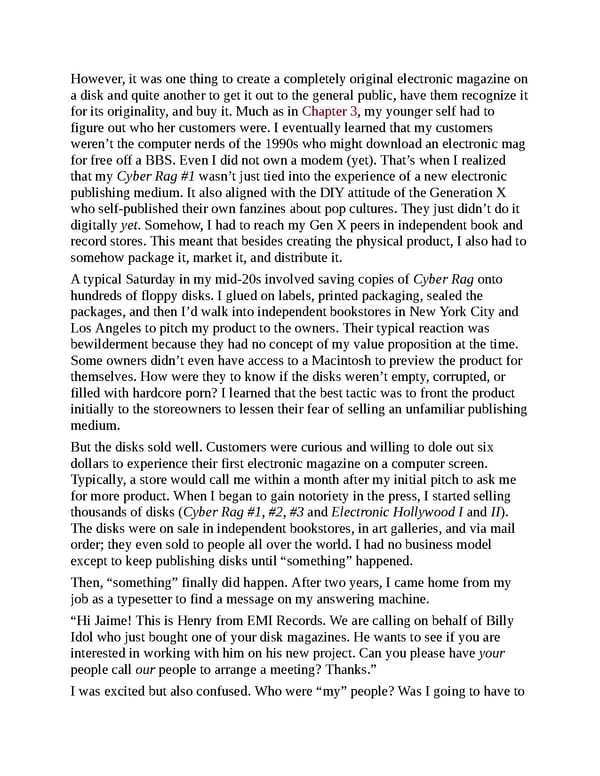However, it was one thing to create a completely original electronic magazine on a disk and quite another to get it out to the general public, have them recognize it for its originality, and buy it. Much as in Chapter 3, my younger self had to figure out who her customers were. I eventually learned that my customers weren’t the computer nerds of the 1990s who might download an electronic mag for free off a BBS. Even I did not own a modem (yet). That’s when I realized that my Cyber Rag #1 wasn’t just tied into the experience of a new electronic publishing medium. It also aligned with the DIY attitude of the Generation X who self-published their own fanzines about pop cultures. They just didn’t do it digitally yet. Somehow, I had to reach my Gen X peers in independent book and record stores. This meant that besides creating the physical product, I also had to somehow package it, market it, and distribute it. A typical Saturday in my mid-20s involved saving copies of Cyber Rag onto hundreds of floppy disks. I glued on labels, printed packaging, sealed the packages, and then I’d walk into independent bookstores in New York City and Los Angeles to pitch my product to the owners. Their typical reaction was bewilderment because they had no concept of my value proposition at the time. Some owners didn’t even have access to a Macintosh to preview the product for themselves. How were they to know if the disks weren’t empty, corrupted, or filled with hardcore porn? I learned that the best tactic was to front the product initially to the storeowners to lessen their fear of selling an unfamiliar publishing medium. But the disks sold well. Customers were curious and willing to dole out six dollars to experience their first electronic magazine on a computer screen. Typically, a store would call me within a month after my initial pitch to ask me for more product. When I began to gain notoriety in the press, I started selling thousands of disks (Cyber Rag #1, #2, #3 and Electronic Hollywood I and II). The disks were on sale in independent bookstores, in art galleries, and via mail order; they even sold to people all over the world. I had no business model except to keep publishing disks until “something” happened. Then, “something” finally did happen. After two years, I came home from my job as a typesetter to find a message on my answering machine. “Hi Jaime! This is Henry from EMI Records. We are calling on behalf of Billy Idol who just bought one of your disk magazines. He wants to see if you are interested in working with him on his new project. Can you please have your people call our people to arrange a meeting? Thanks.” I was excited but also confused. Who were “my” people? Was I going to have to
 UX Strategy: How to Devise Innovative Digital Products that People Want Page 143 Page 145
UX Strategy: How to Devise Innovative Digital Products that People Want Page 143 Page 145